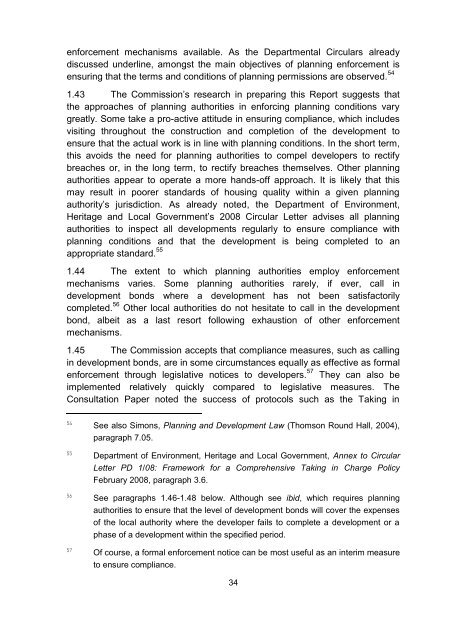Report on Multi-Unit Developments - Law Reform Commission
Report on Multi-Unit Developments - Law Reform Commission
Report on Multi-Unit Developments - Law Reform Commission
You also want an ePaper? Increase the reach of your titles
YUMPU automatically turns print PDFs into web optimized ePapers that Google loves.
enforcement mechanisms available. As the Departmental Circulars already<br />
discussed underline, am<strong>on</strong>gst the main objectives of planning enforcement is<br />
ensuring that the terms and c<strong>on</strong>diti<strong>on</strong>s of planning permissi<strong>on</strong>s are observed. 54<br />
1.43 The Commissi<strong>on</strong>‘s research in preparing this <str<strong>on</strong>g>Report</str<strong>on</strong>g> suggests that<br />
the approaches of planning authorities in enforcing planning c<strong>on</strong>diti<strong>on</strong>s vary<br />
greatly. Some take a pro-active attitude in ensuring compliance, which includes<br />
visiting throughout the c<strong>on</strong>structi<strong>on</strong> and completi<strong>on</strong> of the development to<br />
ensure that the actual work is in line with planning c<strong>on</strong>diti<strong>on</strong>s. In the short term,<br />
this avoids the need for planning authorities to compel developers to rectify<br />
breaches or, in the l<strong>on</strong>g term, to rectify breaches themselves. Other planning<br />
authorities appear to operate a more hands-off approach. It is likely that this<br />
may result in poorer standards of housing quality within a given planning<br />
authority‘s jurisdicti<strong>on</strong>. As already noted, the Department of Envir<strong>on</strong>ment,<br />
Heritage and Local Government‘s 2008 Circular Letter advises all planning<br />
authorities to inspect all developments regularly to ensure compliance with<br />
planning c<strong>on</strong>diti<strong>on</strong>s and that the development is being completed to an<br />
appropriate standard. 55<br />
1.44 The extent to which planning authorities employ enforcement<br />
mechanisms varies. Some planning authorities rarely, if ever, call in<br />
development b<strong>on</strong>ds where a development has not been satisfactorily<br />
completed. 56 Other local authorities do not hesitate to call in the development<br />
b<strong>on</strong>d, albeit as a last resort following exhausti<strong>on</strong> of other enforcement<br />
mechanisms.<br />
1.45 The Commissi<strong>on</strong> accepts that compliance measures, such as calling<br />
in development b<strong>on</strong>ds, are in some circumstances equally as effective as formal<br />
enforcement through legislative notices to developers. 57 They can also be<br />
implemented relatively quickly compared to legislative measures. The<br />
C<strong>on</strong>sultati<strong>on</strong> Paper noted the success of protocols such as the Taking in<br />
54<br />
See also Sim<strong>on</strong>s, Planning and Development <strong>Law</strong> (Thoms<strong>on</strong> Round Hall, 2004),<br />
paragraph 7.05.<br />
55<br />
Department of Envir<strong>on</strong>ment, Heritage and Local Government, Annex to Circular<br />
Letter PD 1/08: Framework for a Comprehensive Taking in Charge Policy<br />
February 2008, paragraph 3.6.<br />
56<br />
See paragraphs 1.46-1.48 below. Although see ibid, which requires planning<br />
authorities to ensure that the level of development b<strong>on</strong>ds will cover the expenses<br />
of the local authority where the developer fails to complete a development or a<br />
phase of a development within the specified period.<br />
57<br />
Of course, a formal enforcement notice can be most useful as an interim measure<br />
to ensure compliance.<br />
34

















